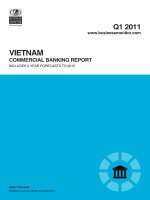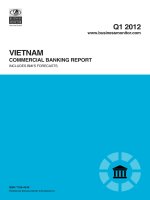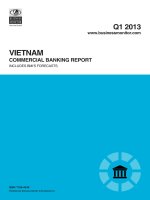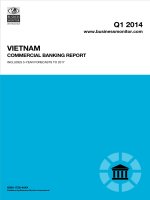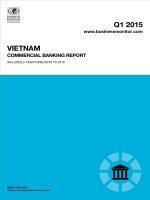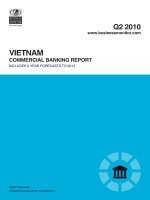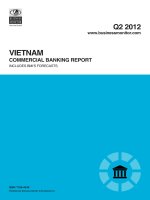Vietnam commercial banking report q3 2014
Bạn đang xem bản rút gọn của tài liệu. Xem và tải ngay bản đầy đủ của tài liệu tại đây (443.23 KB, 72 trang )
Q3 2014
www.businessmonitor.com
VIETNAM
COMMERCIAL BANKING REPORT
INCLUDES 5-YEAR FORECASTS TO 2018
ISSN 1758-454X
Published by:Business Monitor International
Vietnam Commercial Banking
Report Q3 2014
INCLUDES 5-YEAR FORECASTS TO 2018
Part of BMI’s Industry Report & Forecasts Series
Published by: Business Monitor International
Copy deadline: May 2014
Business Monitor International
Senator House
85 Queen Victoria Street
London
EC4V 4AB
United Kingdom
Tel: +44 (0) 20 7248 0468
Fax: +44 (0) 20 7248 0467
Email:
Web:
© 2014 Business Monitor International
All rights reserved.
All information contained in this publication is
copyrighted in the name of Business Monitor
International, and as such no part of this
publication may be reproduced, repackaged,
redistributed, resold in whole or in any part, or used
in any form or by any means graphic, electronic or
mechanical, including photocopying, recording,
taping, or by information storage or retrieval, or by
any other means, without the express written consent
of the publisher.
DISCLAIMER
All information contained in this publication has been researched and compiled from sources believed to be accurate and reliable at the time of
publishing. However, in view of the natural scope for human and/or mechanical error, either at source or during production, Business Monitor
International accepts no liability whatsoever for any loss or damage resulting from errors, inaccuracies or omissions affecting any part of the
publication. All information is provided without warranty, and Business Monitor International makes no representation of warranty of any kind as
to the accuracy or completeness of any information hereto contained.
CONTENTS
BMI Industry View 7
Table: Commercial Banking Sector Indicators 7
Table: Commercial Banking Sector Key Ratios, July 2013 7
Table: Annual Growth Rate Projections 2013-2018 (%) 7
Table: Ranking Out Of 72 Countries Reviewed In 2014 8
Table: Commercial Banking Sector Indicators, 2011-2018 8
SWOT 9
Commercial Banking 9
Political 10
Economic 11
Business Environment 12
Industry Forecast 13
Industry Risk Reward Ratings 18
Asia Commercial Banking Risk/Reward Ratings 18
Table: Asia Commercial Banking Risk/Reward Ratings 19
Market Overview 20
Asia Commercial Banking Outlook 20
Table: Banks' Bond Portfolios, 2013 20
Table: Comparison of Loan/Deposit & Loan/Asset & Loan/GDP ratios, 2014 20
Table: Comparison of Total Assets & Client Loans & Client Deposits (USDbn) 21
Table: Comparison of USD Per Capita Deposits, 2014 22
Macroeconomic Forecasts 22
Table: Vietnam - Economic Activity 25
Competitive Landscape 26
Market Structure 26
Protagonists 26
Table: Protagonists In Vietnam's Commercial Banking Sector 26
Definition Of The Commercial Banking Universe 26
List Of Banks 27
Table: Financial Institutions In Vietnam 27
Company Profile 29
Agribank 29
Table: Balance Sheet (VNDmn) 31
Table: Balance Sheet (USDmn) 31
Table: Key Ratios (%) 31
Asia Commercial Bank 32
Table: Stock Market Indicators 33
Table: Balance Sheet (VNDmn) 34
Vietnam Commercial Banking Report Q3 2014
© Business Monitor International Page 4
Table: Balance Sheet (USDmn) 34
Table: Key Ratios (%) 34
Bank for Foreign Trade of Vietnam (Vietcombank) 35
Table: Stock Market Indicator 37
Table: Balance Sheet (VNDmn) 37
Table: Balance Sheet (USDmn) 38
Table: Key Ratios (%) 38
Eximbank 39
Table: Stock Market Indicators 41
Table: Balance Sheet (VNDmn) 41
Table: Balance Sheet (USDmn) 41
Table: Key Ratios (%) 42
Housing Development Commercial Joint Stock Bank (HDBank) 43
Sacombank 45
Table: Stock Market Indicators 47
Table: Balance Sheet (VNDmn) 47
Table: Balance Sheet (USDmn) 48
Table: Key Ratios (%) 48
VietinBank 49
Table: Stock Market Indicators 51
Table: Balance Sheet (VNDmn) 51
Table: Balance Sheet (USDmn) 52
Table: Key Ratios (%) 52
Regional Overview 53
Asia Overview 53
Global Industry Overview 56
Global Commercial Banking Outlook 56
Regional Outlooks 56
Demographic Forecast 63
Table: Vietnam's Population By Age Group, 1990-2020 ('000) 64
Table: Vietnam's Population By Age Group, 1990-2020 (% of total) 65
Table: Vietnam's Key Population Ratios, 1990-2020 66
Table: Vietnam's Rural And Urban Population, 1990-2020 66
Methodology 67
Industry Forecast Methodology 67
Sector-Specific Methodology 68
Risk/Reward Ratings Methodology 69
Table: Commercial Banking Risk/Reward Rating Indicators 70
Table: Weighting Of Indicators 71
Vietnam Commercial Banking Report Q3 2014
© Business Monitor International Page 5
BMI Industry View
Table: Commercial Banking Sector Indicators
Date
Total
assets
Client
loans
Bond
portfolio Other
Liabilities
and capital Capital
Client
deposits Other
July 2012, VNDbn 3,567,430 2,861,000 336,215 370,215 3,567,430 575,090 2,732,308 260,032
July 2013, VNDbn 4,162,373 3,256,543 469,827 436,003 4,162,373 611,598 3,445,097 105,678
% change y-o-y 16.7% 13.8% 39.7% 17.8% 16.7% 6.3% 26.1% -59.4%
July 2012, USDbn 170.9 137.1 16.1 17.7 170.9 27.6 130.9 12.5
July 2013, USDbn 196.6 153.8 22.2 20.6 196.6 28.9 162.7 5.0
% change y-o-y 15.0% 12.2% 37.7% 16.1% 15.0% 4.8% 24.3% -59.9%
Source: BMI; Central banks; Regulators
Table: Commercial Banking Sector Key Ratios, July 2013
Loan/deposit ratio
Loan/asset ratio Loan/GDP ratio GDP Per Capita, USD Deposits per capita, USD
94.53% 78.24% 93.59% 1,903.4 1,781.8
Falling Rising Falling n.a. n.a.
Source: BMI; Central banks; Regulators
Table: Annual Growth Rate Projections 2013-2018 (%)
Assets Loans Deposits
Annual Growth Rate 11 9 6
CAGR 12 10 7
Ranking 21 29 45
Source: BMI; Central banks; Regulators
Vietnam Commercial Banking Report Q3 2014
© Business Monitor International Page 7
Table: Ranking Out Of 72 Countries Reviewed In 2014
Loan/deposit ratio Loan/asset ratio Loan/GDP ratio
17 3 18
Local currency asset growth Local currency loan growth Local currency deposit growth
19 21 26
Source: BMI; Central banks; Regulators
Table: Commercial Banking Sector Indicators, 2011-2018
2011 2012 2013e 2014f 2015f 2016f 2017f 2018f
Total assets, VNDbn 3,437,893 3,917,557 4,466,015 5,091,257 5,753,121 6,443,495 7,152,280 7,939,030
Total assets, USDbn 163.4 188.0 212.7 247.6 283.0 320.6 359.4 403.0
Client loans, VNDbn 2,829,890 3,077,700 3,447,024 3,860,667 4,285,340 4,713,874 5,138,123 5,600,554
Client loans, USDbn 134.5 147.7 164.1 187.7 210.8 234.5 258.2 284.3
Client deposits, VNDbn 2,483,357 3,080,455 3,388,501 3,693,466 3,988,943 4,268,169 4,524,259 4,795,715
Client deposits, USDbn 118.1 147.8 161.4 179.6 196.2 212.3 227.3 243.4
e/f = estimate/forecast. Source: BMI; Central banks; Regulators
Vietnam Commercial Banking Report Q3 2014
© Business Monitor International Page 8
SWOT
Commercial Banking
Vietnam Commercial Banking SWOT
Strengths
■
Untapped market with potential for increased participation of foreign banks.
■
Large population with a high savings rate and potential for income growth.
■
The Vietnamese government aims to speed up the process of privatising state-owned
banks, which will help modernise the industry.
■
State-owned banks will play a lesser role going forward, and the risks associated with
state-directed lending will decrease over time.
Weaknesses
■
Domestic banks continue to lag behind their foreign peers in terms of financial
strength and the technological curve.
■
Accounting standards lag far behind international standards and the lack of
transparency entails significant risks for foreign investors.
■
Small banks have an overwhelming exposure to real estate and individual loans,
resulting in highly skewed and risky loan portfolios.
Opportunities
■
The population is still underbanked, with significant potential for adopting cash-free
payment systems and new mobile banking technologies.
■
Rising income levels and deepening capital markets could give rise to opportunities in
more sophisticated financial products and growth for the local asset management
industry.
Threats
■
Track record of macroeconomic instability threatens the credibility of the government
and could potentially drive economic policy away from further liberalisation.
■
The high level of government debt risks triggering a fiscal crisis, undermining
confidence in the banking sector.
Vietnam Commercial Banking Report Q3 2014
© Business Monitor International Page 9
Political
SWOT Analysis
Strengths
■
The Communist Party of Vietnam remains committed to market-oriented reforms and
we do not expect major shifts in policy direction over the next five years. The one-
party system is generally conducive to short-term political stability.
■
Relations with the US have witnessed a marked improvement, and Washington sees
Hanoi as a potential geopolitical ally in South East Asia.
Weaknesses
■
Corruption among government officials poses a major threat to the legitimacy of the
ruling Communist Party.
■
There is increasing (albeit still limited) public dissatisfaction with the leadership's tight
control over political dissent.
Opportunities
■
The government recognises the threat corruption poses to its legitimacy, and has
acted to clamp down on graft among party officials.
■
Vietnam has allowed legislators to become more vocal in criticising government
policies. This is opening up opportunities for more checks and balances within the
one-party system.
Threats
■
Macroeconomic instabilities continue to weigh on public acceptance of the one-party
system, and street demonstrations to protest economic conditions could develop into
a full-on challenge of undemocractic rule.
■
Although strong domestic control will ensure little change to Vietnam's political scene
in the next few years, over the longer term, the one-party-state will probably be
unsustainable.
■
Relations with China have deteriorated over recent years due to Beijing's more
assertive stance over disputed islands in the South China Sea and domestic criticism
of a large Chinese investment into a bauxite mining project in the central highlands,
which could potentially cause wide-scale environmental damage.
Vietnam Commercial Banking Report Q3 2014
© Business Monitor International Page 10
Economic
SWOT Analysis
Strengths
■
Vietnam has been one of the fastest-growing economies in Asia in recent years, with
GDP growth averaging 7.1% annually between 2000 and 2012.
■
The economic boom has lifted many Vietnamese out of poverty, with the official
poverty rate in the country falling from 58% in 1993 to 20.7% in 2012.
Weaknesses
■
Vietnam still suffers from substantial trade and fiscal deficits, leaving the economy
vulnerable to global economic uncertainties. The fiscal deficit is dominated by
substantial spending on social subsidies that could be difficult to withdraw.
■
The heavily-managed and weak currency reduces incentives to improve quality of
exports, and also keeps import costs high, contributing to inflationary pressures.
Opportunities
■
WTO membership and the upcoming ASEAN AEC in 2015 should give Vietnam
greater access to both foreign markets and capital, while making Vietnamese
enterprises stronger through increased competition.
■
The government will in spite of the current macroeconomic woes, continue to move
forward with market reforms, including privatisation of state-owned enterprises, and
liberalising the banking sector.
■
Urbanisation will continue to be a long-term growth driver. The UN forecasts the
urban population rising from 29% of the population to more than 50% by the early
2040s.
Threats
■
Inflation and deficit concerns have caused some investors to re-assess their hitherto
upbeat view of Vietnam. If the government focuses too much on stimulating growth
and fails to root out inflationary pressure, it risks prolonging macroeconomic
instability, which could lead to a potential crisis.
■
Prolonged macroeconomic instability could prompt the authorities to put reforms on
hold as they struggle to stabilise the economy.
Vietnam Commercial Banking Report Q3 2014
© Business Monitor International Page 11
Business Environment
SWOT Analysis
Strengths
■
Vietnam has a large, skilled and low-cost workforce, which has made the country
attractive to foreign investors.
■
Vietnam's location - its proximity to China and South East Asia, and its good sea links
- makes it a good base for foreign companies to export to the rest of Asia, and
beyond.
Weaknesses
■
Vietnam's infrastructure is still weak. Roads, railways and ports are inadequate to
cope with the country's economic growth and links with the outside world.
■
Vietnam remains one of the world's most corrupt countries. According to
Transparency International's 2012 Corruption Perceptions Index, Vietnam ranks 123
out of 176 countries.
Opportunities
■
Vietnam is increasingly attracting investment from key Asian economies, such as
Japan, South Korea and Taiwan. This offers the possibility of the transfer of high-tech
skills and know-how.
■
Vietnam is pressing ahead with the privatisation of state-owned enterprises and the
liberalisation of the banking sector. This should offer foreign investors new entry
points.
Threats
■
Ongoing trade disputes with the US, and the general threat of American
protectionism, which will remain a concern.
■
Labour unrest remains a lingering threat. A failure by the authorities to boost skills
levels could leave Vietnam a second-rate economy for an indefinite period.
Vietnam Commercial Banking Report Q3 2014
© Business Monitor International Page 12
Industry Forecast
BMI View: We forecast the Vietnamese banking sector to continue to strengthen over the coming years as
reform momentum picks up. That said, the improvement will be gradual, given the oversized role of the state
as well as slow implementation of key measures. We also highlight the risk of a higher-than-expected level
of non-performing loans.
Vietnam's banking sector remains relatively underdeveloped, with a below-average level of assets relative
to GDP and a still-strong presence of state banks. However, given the ongoing reform and growth drive by
the government, we forecast the banking sector (as measured by assets) to grow by an average of 12.5% out
to 2018, with assets rising to 124% of GDP, from the 2012 reading of 120%. Going forward, we see three
broad trends over the coming years for the Vietnamese banking sector, all of which will continue to
underpin the improvement in the general economy. These include broad sector consolidation and improving
profitability, increased financial sector depth and liquidity, and lastly, stronger credit growth and a focus on
the consumer and mortgage markets. With regard to the first point, the government will continue to push for
the consolidation of the sector by shutting down, or merging unprofitable operations while attracting foreign
investment in an effort to recapitalise the banking sector. Although reform will remain a key priority for the
government, we highlight that it risks not going far enough to attract sufficient investment at this stage. In
February, foreign ownership ceilings were raised from 10% to 15% for organisations and from 15% to 20%
for strategic investors. However, the cap on total foreign ownership remained at 30% which, according to
several investors, is not high enough to compensate investors for the risk involved. The silver lining
however, is that there is potential for these ceilings to be raised again in the near future given reports that
the government would be willing to raise them again once the sector is more stable.
Vietnam Commercial Banking Report Q3 2014
© Business Monitor International Page 13
Below Average, But With Room To Grow
Asia - Assets to GDP, %
Source: Respective Central Banks, Banking Authorities, IMF
We believe that the ongoing reform to the financial sector, which includes the purchasing of bad debt from
state-owned enterprises (SOEs), recapitalising the banking sector and raising ownership caps, will bode well
for the sector's profit margins over the long term. Figures reported by the media vary, but estimates suggest
that the Vietnam Asset Management Company (VAMC) purchased about USD2.13bn of bad debts so far
and continued progress on this front will help relieve pressure on bank's balance sheets. Moreover, earlier
this year, the State Bank of Vietnam (SBV) postponed the implementation of stricter debt classification
standards from June 2014 to April 2015, which will provide banks more time before they have to re-
categorise debt under more rigorous standards. Although this decision will temporarily slow the reform
momentum, policymakers are moving in the right direction.
Vietnam Commercial Banking Report Q3 2014
© Business Monitor International Page 14
Profit Margins To Improve
Vietnam - Profit Margins For Saigon Thuong Tin Commercial JSB
Source: Bloomberg
Increased Stability, Growth & Sector Depth
Government-owned banks account for the largest share of assets in the banking sector, but we expect this
trend to decline over the coming years. When measured by assets, state-owned banks account for
approximately 44.0% of total assets as of March 2014. This is closely followed by joint stock commercial
banks, which account for 42.0% of the total. That said, we expect the privatisation drive by the government,
combined with efforts to boost foreign participation, will result in a decline in the share of assets held by
state banks, and will also lead to an improvement in the overall stability of the banking sector. Aggregate
assets expanded by a meagre 0.9% year-on-year (y-o-y) in March 2014, with most of the growth coming
from joint-venture and 100% foreign-owned banks, rather than state-owned banks.
Financial depth has also improved in recent quarters with data showing that Vietnamese citizens are
increasingly using financial services - a trend we expect will remain in place over the coming years. In the
period between March 2013 and March 2014, the number of bank accounts increased by 11.3% y-o-y, with
the value of deposits rising by a faster 17.6% y-o-y to VND116.0bn. Moreover, the number of bank cards
Vietnam Commercial Banking Report Q3 2014
© Business Monitor International Page 15
issued rose by a stellar 20.0% y-o-y over the period, with the value of transactions via ATMs (Automatic
Telling Machine) and POSs (point of sale) rising by 33.4% y-o-y. These figures suggest that the ongoing
efforts by the government to increase the depth of the banking sector is working, through improvements in
both liquidity as well as access to financial services.
Government Share To Decline
Vietnam - Banking Sector Assets By Type (%)
Source: State Bank of Vietnam
Credit & Mortgage Growth To Remain A Focus
In line with improving financial sector depth, the SBV will continue to focus on stimulating credit growth in
both the consumer and mortgage markets. The SBV is targeting annual credit growth of about 12-14% for
2014 and has been taking steps to lower borrowing costs (it cut the refinancing rate by 50 basis points in
March to 6.50%) in an effort to boost lending. The SBV is also committed to expanding credit growth in the
home-loan and mortgage market with recent measures including an improvement to the guidelines and
procedures for obtaining mortgages from credit institutions, which will take effect in June 2014, as well as
an extension to home subsidy loans. In an effort to reduce inventory in the real estate market, the SBV
Vietnam Commercial Banking Report Q3 2014
© Business Monitor International Page 16
reserved VND30bn to help state-owned commercial banks to extend subsidy home loans and data showed
that as of March, 10% of the subsidy home loan package had been accessed.
Risks To Outlook
Although the banking sector is most likely past the worst, we see two risks over the coming years. First,
there is uncertainty surrounding the level of non-performing loans (NPL). While the SBV has taken steps to
purchase bad debt, and to help credit institutions to resolve NPLs, there is a wide range of estimates in terms
of the real level of bad loans. According to news reports, the deputy chief inspector of the State Bank of
Vietnam, Dao Quang Tinh, estimated that total bad debt for commercial banks stood at 9.7%, but later
revised the estimate to 3.9% following the debt restructuring in February. This is in stark contrast to
Moody's assessment, which puts the level of NPLs closer to 15%. Moreover, given that the deadline for
banks to apply more rigorous standards to their categorisation of debt was delayed, it could see NPLs
surprise on the upside once the new, stricter standards are implemented next year, particularly if the
government aggressively pushes subsidized home loans. Such a scenario would weigh on both growth and
profitability of the banking sector. Second, we highlight that a slowdown in reforms, or a sustained bout of
political risk with China could dent investor's confidence in the sector. With the Vietnamese government
relying on a privatisation drive partially funded by foreign direct investment, any deterioration in the
business environment could weigh heavily on the progress of the banking sector, and hence growth over the
coming years.
Vietnam Commercial Banking Report Q3 2014
© Business Monitor International Page 17
Industry Risk Reward Ratings
Asia Commercial Banking Risk/Reward Ratings
Commercial Banking Risk/Reward Rating Methodology
Since Q108, we have described numerically the banking business environment for each of the countries
analysed by BMI. We do this through our Commercial Banking Industry Risk/Reward Rating (IRR), a
measure that ensures we capture the latest quantitative information available. It also ensures consistency
across all countries. Like all of BMI's Industry Risk/Reward Ratings, its takes into account the Rewards on
offer within the banking sector in a given country, but also the Risks to investors being able to realise those
opportunities. The overall Rating is weighted 70% towards Rewards and 30% towards Risks.
Within the Rewards category, we look at factors that are specific to the banking industry (accounting for
60% of the score within this category), and elements that relate to that country in general (accounting for
40% of the weighting). These include, but are not limited to, total assets, asset and loan growth, GDP and
taxation. Likewise on the Risks side, we look at industry-specific Risks (weighted 40% of the Risks total)
and country-specific Risks (weighted 60%). These include, but are not limited to, the regulatory framework
and environment, the competitive environment, financial risk, legal risk and policy continuity.
In general three aspects need to be borne in mind when interpreting the IRRs. The first is that the Industry
Rewards element is the most heavily weighted of the four elements, accounting for 42% (60% of 70%) of
the overall Rating. Second, if the Industry Rewards score is significantly higher than the Country Rewards
score, within the Rewards category, it usually implies that the banking sector is (very) large and/or
developed relative to the general wealth, stability and financial infrastructure in the country. Conversely, if
the industry score is significantly lower, it usually means that the banking sector is small and/or
underdeveloped relative to the general wealth, stability and financial infrastructure in the country. Third,
within the Risks category, the industry-specific elements (i.e. how regulations affect the development of the
sector, how regulations affect competition within it, and Moody's Investor Services' ratings for local
currency deposits) can be markedly different from BMI's long-term Country Risk rating for a given market.
Vietnam Commercial Banking Report Q3 2014
© Business Monitor International Page 18
Table: Asia Commercial Banking Risk/Reward Ratings
Limits of Potential Returns Risks to Potential Returns Overall
Market Structure Country Structure Market Risks Country Risks Rating Ranking
Bangladesh 56.7 45.0 43.3 44.0 49.5 54
China 93.3 57.5 63.3 74.0 76.2 14
Hong Kong 80.0 95.0 73.3 78.0 83.0 6
India 83.3 57.5 60.0 54.0 68.0 30
Indonesia 76.7 65.0 80.0 52.0 69.4 26
Japan 46.7 75.0 66.7 80.0 63.0 34
Malaysia 73.3 80.0 83.3 80.0 77.6 10
Pakistan 50.0 50.0 53.3 44.0 49.3 55
Philippines 53.3 62.5 60.0 60.0 57.9 40
Singapore 66.7 95.0 96.7 90.0 82.4 7
Sri Lanka 33.3 55.0 33.3 46.0 41.7 62
South Korea 76.7 85.0 83.3 76.0 79.7 9
Taiwan 76.7 72.5 86.7 76.0 76.6 12
Thailand 66.7 67.5 86.7 74.0 70.6 23
Vietnam 60.0 57.5 36.7 54.0 55.4 43
United States 93.3 85.0 100.0 82.0 89.8 1
Scores out of 100, with 100 the highest. Source: BMI
Vietnam Commercial Banking Report Q3 2014
© Business Monitor International Page 19
Market Overview
Asia Commercial Banking Outlook
Table: Banks' Bond Portfolios, 2013
Bond Portfolio, USDbn Bond as % total assets Year-on-year growth %
Bangladesh* 20.0 22.5 13.9
China* 1,873.0 8.7 17.5
Hong Kong* 379.3 19.8 8.1
India* 352.5 25.8 14.4
Indonesia** 17.3 4.3 17.7
Japan 2,536.0 28.0 -4.5
Malaysia 83.6 12.8 -4.6
Pakistan 41.2 42.7 5.9
Philippines 52.1 25.7 31.9
Singapore 93.2 12.1 5.4
Sri Lanka* 5.1 17.3 25.5
South Korea* 295.0 16.7 0.4
Taiwan* 115.2 9.0 12.6
Thailand 83.5 16.3 4.7
Vietnam* 20.4 10.9 64.4
United States 486.0 3.5 -8.6
Source: Central banks, regulators, BMI. **Only 2011 data available. * Only 2012 data available.
Table: Comparison of Loan/Deposit & Loan/Asset & Loan/GDP ratios, 2014
Loan/Deposit
ratio % Rank Trend
Loan/Asset
ratio % Rank Trend
Loan/GDP
ratio % Rank Trend
Bangladesh 89.4 37 Falling 67.1 12 Falling 55.2 46 Rising
China 76.6 56 Falling 50.9 46 Rising 132.6 8 Falling
Hong Kong 71.0 62 Rising 38.5 64 Rising 300.1 1 Rising
India 78.7 54 Falling 67.0 13 Falling 60.3 38 Rising
Indonesia 84.6 45 Falling 65.3 18 Falling 35.2 56 Falling
Japan 68.6 64 Falling 48.1 52 Falling 90.1 20 Falling
Malaysia 76.1 58 Falling 60.1 34 Falling 117.7 11 Falling
Vietnam Commercial Banking Report Q3 2014
© Business Monitor International Page 20
Comparison of Loan/Deposit & Loan/Asset & Loan/GDP ratios, 2014 - Continued
Loan/Deposit
ratio % Rank Trend
Loan/Asset
ratio % Rank Trend
Loan/GDP
ratio % Rank Trend
Pakistan 57.2 68 Falling 46.0 57 Falling 21.1 66 Rising
Philippines 64.6 66 Rising 48.8 48 Rising 37.4 55 Rising
Singapore 110.3 12 Rising 64.2 20 Rising 163.5 5 Rising
Sri Lanka 85.2 43 Rising 61.4 30 Falling 32.8 58 Rising
South Korea 112.0 11 Falling 71.4 8 Falling 105.9 13 Falling
Taiwan 81.4 51 Rising 64.1 21 Rising 170.3 3 Rising
Thailand 99.1 24 Falling 67.3 11 Rising 88.6 22 Falling
Vietnam 104.5 17 Rising 75.8 3 Falling 94.4 17 Falling
United States 103.2 19 Rising 72.6 6 Rising 60.3 37 Rising
Source: Central banks, regulators, BMI
Table: Comparison of Total Assets & Client Loans & Client Deposits (USDbn)
2014 2013
Total Assets Client Loans Client Deposits Total Assets Client Loans Client Deposits
Bangladesh 125.8 84.4 94.4 107.1 71.8 79.4
China 26,237.0 13,344.6 17,415.4 25,557.7 12,753.8 16,488.9
Hong Kong 2,333.2 897.5 1,263.8 2,180.6 831.0 1,181.1
India 1,879.7 1,259.6 1,601.3 1,500.1 1,005.2 1,256.6
Indonesia 491.1 320.7 379.1 423.5 281.4 313.2
Japan 9,254.3 4,448.0 6,481.2 9,072.8 4,382.3 6,292.4
Malaysia 702.3 422.2 554.8 651.7 391.7 491.6
Pakistan 109.6 50.4 88.1 96.4 44.3 73.1
Philippines 224.4 109.6 169.8 202.7 95.9 154.0
Singapore 801.9 514.5 466.6 770.5 454.6 425.6
Sri Lanka 39.9 24.5 28.8 33.8 20.7 24.7
South Korea 1,868.0 1,332.9 1,189.9 1,755.6 1,252.7 1,099.4
Taiwan 1,430.3 917.4 1,126.9 1,327.9 830.1 1,046.2
Thailand 553.5 372.3 375.6 513.7 343.9 347.0
Vietnam 247.6 187.7 179.6 212.7 164.1 161.4
Vietnam Commercial Banking Report Q3 2014
© Business Monitor International Page 21
Comparison of Total Assets & Client Loans & Client Deposits (USDbn) - Continued
2014 2013
United States 15,017.0 10,908.9 10,569.4 14,034.6 10,147.8 9,877.9
Source: Central banks, regulators, BMI
Table: Comparison of USD Per Capita Deposits, 2014
GDP Per Capita
Client Deposits, per
capita
Rich 20% Client
Deposits, per capita
Poor 80% Client
Deposits, per capita
Bangladesh 964 596 2,383 149
China 7,269 12,495 49,980 3,124
Hong Kong 41,191 174,091 696,364 43,523
India 1,607 1,263 5,054 316
Indonesia 3,572 1,500 5,999 375
Japan 38,864 51,033 204,132 12,758
Malaysia 11,779 18,379 73,516 4,595
Pakistan 1,308 476 1,903 119
Philippines 2,897 1,696 6,784 424
Singapore 57,037 84,576 338,303 21,144
Sri Lanka 3,491 1,341 5,363 335
South Korea 25,420 24,033 96,134 6,008
Taiwan 22,375 48,099 192,395 12,025
Thailand 6,174 5,588 22,350 1,397
Vietnam 2,148 1,941 7,762 485
United States 56,067 32,765 131,059 8,191
Source: Central banks, regulators, BMI
Macroeconomic Forecasts
BMI View: Vietnam's latest real GDP reading, which showed that the economy expanded by 6.0% year-on-
year (y-o-y) in Q413, has reaffirmed our conviction that the Vietnamese economy will begin 2014 on a
strong note. Not only are we witnessing more evidence of a sustained pick-up in production activity and
employment in the manufacturing sector, but we also expect foreign direct investment (FDI) inflows to
accelerate as the economic recovery gathers pace over the coming quarters. We forecast real GDP growth
to come in at 5.9% in 2014, versus Bloomberg consensus of 5.5%.
Vietnam Commercial Banking Report Q3 2014
© Business Monitor International Page 22
In line with our view that the Vietnamese economy would accelerate forcefully into the final months of the
year (see 'Economy Picking Up Pace', October 4 2013), latest data released by the General Statistics Office
(GSO) showed that the economy expanded by 6.0% year-on-year (y-o-y) in Q413. This translates into full-
year growth of 5.4% for 2013, just slightly above our forecast of 5.3%. The latest GDP reading, combined
with the strong set of economic data we have seen in recent weeks (accelerating foreign direct investment
inflows, remittances, and merchandise trade exports), have reaffirmed our conviction that the Vietnamese
economy will begin 2014 on a strong note.
Looking At A Strong Start For 2014
Vietnam - Real GDP Growth, % (LHS) & Contribution By GFCF & Private Consumption, pp (RHS)
Source: BMI, General Statistics Office. (e = estimates, f = BMI forecasts)
Signs Of Improvement
Despite the lack of progress with regards to banking sector reforms and efforts to ease lending conditions
(credit growth is estimated to have expanded by around 9% in 2013, well under the State Bank of Vietnam's
initial target of 12%), the economy appears to be holding up well. Not only are we witnessing more
evidence of a sustained pick-up in production activity and employment in the manufacturing sector (see
'Strong PMI Reading Reinforces Outlook On Growth', November 5 2013), but we also expect foreign direct
Vietnam Commercial Banking Report Q3 2014
© Business Monitor International Page 23
investment (FDI) inflows into the export sector to accelerate as the economic recovery gathers pace over the
coming quarters.
Private Sector Investment To Drive Recovery
According to figures published by GSO, FDI-related exports made up an estimated 67% of the country's
total exports for the first 11 months of the year. Thus, although increased FDI inflows could potentially
result in a temporary deterioration in the country's trade and current account dynamics due to a burst of
capital goods imports in the near term, we believe that this is a long-term positive for the economy.
Furthermore, we view FDI inflows as a crucial source of economic growth over the coming quarters given
that the Vietnamese government is struggling to unlock domestic lending. We forecast real gross fixed
capital formation (GFCF) growth to come in at around 10% in 2014, contributing around 2.7 percentage
points (pp) to our real GDP growth forecast of 5.9%.
Expenditure Breakdown
Private Consumption: We expect private consumption to grow at a relatively resilient pace of 6.5% in
2014. However, we note that the risk of further bankruptcies among SMEs could potentially lead to
widespread job losses, especially in export-driven sectors. Uncertainties over the outlook for employment
could, in turn, prompt households to cut back on spending.
Gross Fixed Capital Formation: We foresee a pickup in private sector investment growth in 2014, partly
led by increased foreign direct investment inflows. We believe lending rates will gradually ease over the
coming months as the effect of rate cuts in 2013 by the SBV begins to kick in. We are also seeing evidence
that credit conditions are improving. Accordingly, we expect gross fixed capital formation growth to
accelerate substantially from 4.1% in 2013 to 10.0% in 2014.
Public Spending: We expect total public spending to remain relatively resilient in 2014, expanding at a
respectable pace of 6.5%. However, there is limited room for the government to increase spending further
owing to concerns over the need to finance a potential bailout of ailing state-owned commercial banks.
Net Exports: Net exports remain the biggest downside risk to our outlook for the Vietnamese economy,
although we expect external demand to pick up in 2014. Vietnam's trade account has fallen back into
deficits in recent months, but we see the case for a substantial pickup in external demand on the back of a
rebound in regional growth over the coming quarters. Accordingly, we still expect exports to expand at a
moderate pace of 5.6% in 2014.
Vietnam Commercial Banking Report Q3 2014
© Business Monitor International Page 24
Table: Vietnam - Economic Activity
2011 2012 2013e 2014f 2015f 2016f 2017f 2018f
Nominal GDP,
VNDbn 3 2,779,880.2 3,245,419.2 3,584,261.0 4,012,847.7 4,494,844.6 5,033,219.9 5,616,365.8 6,269,265.3
Nominal GDP,
US$bn 3 134.6 155.6 170.6 195.1 221.1 249 280.8 316.6
Real GDP
growth, %y-o-y 3 6.2 5.2 5.4 5.9 6.4 6.6 6.4 6.4
GDP per capita,
US$ 3 1,497 1,713 1,860 2,108 2,368 2,643 2,957 3,309
Population, mn 4 89.9 90.8 91.7e 92.5 93.4 94.2 95 95.7
Industrial
production, %y-
o-y, ave 1,5 10.9 7.0 5.9 7.7 8.4 8.6 8.6 8.5
Unemployment,
% of labour
force, eop 2,6 3.6 3.2 3.7e 3.5 3.5 3.6 3.5 3.5
Notes:
e
BMI estimates.
f
BMI forecasts.
1
at 1994 prices;
2
Urban Area Only. Sources:
3
Asian Development Bank,
General Statistics Office;
4
World Bank/UN/BMI;
5
General Statistics Office;
6
General Statistics Office/BMI.
Vietnam Commercial Banking Report Q3 2014
© Business Monitor International Page 25

